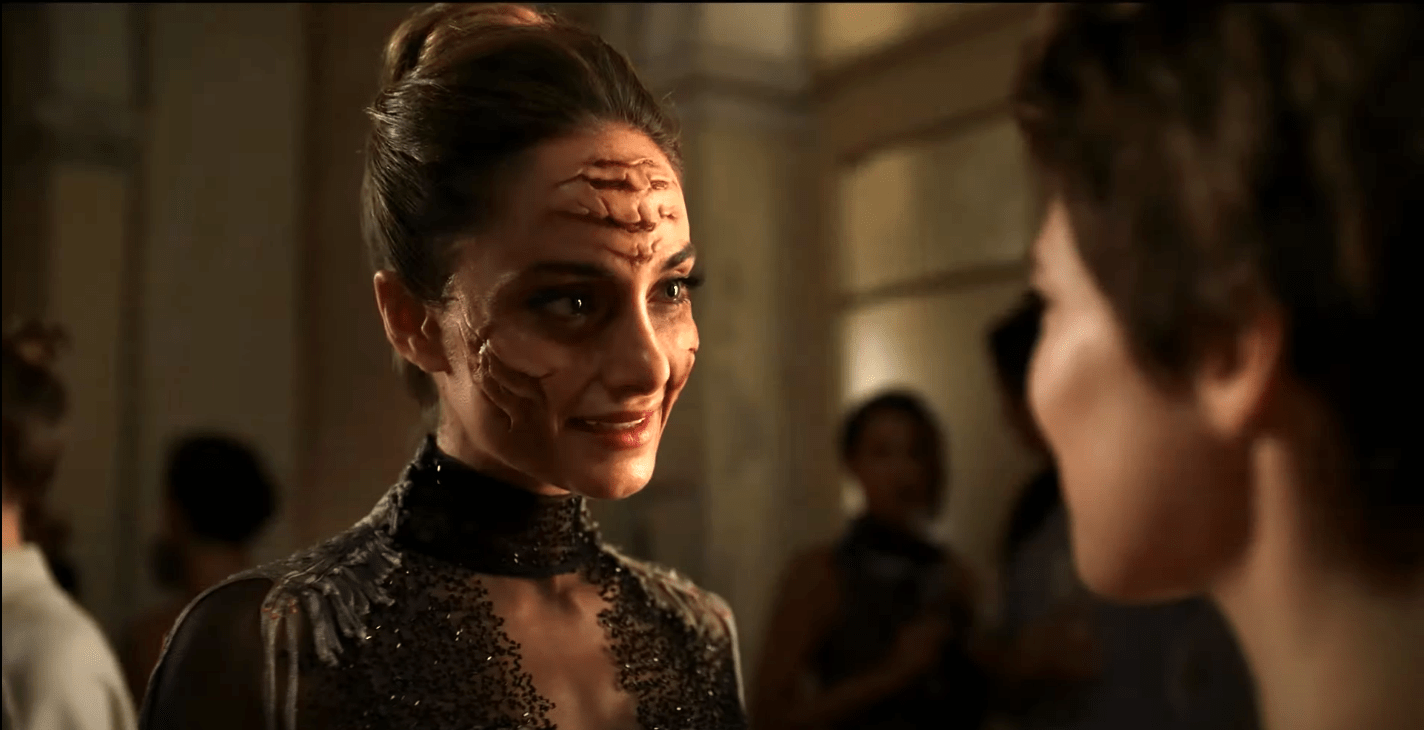David Cronenberg first began writing “Crimes of the Future” in 1998. More than 20 years later, his vision of the future rings true with contemporary audiences — particularly queer audiences, who have always found recognition in the horror genre, despite how horror films have historically villainized trans people (or, at the very least, have made trans people the butt of a joke that has never been funny). Perhaps unintentionally, “Crimes of the Future” and the questions it raises about bodily autonomy makes for a starkly trans-coded film. In a time where trans people are increasingly being denied agency over their own bodies, Cronenberg’s newest film and the future it illustrates is not hard to conceptualize.
In a post- or near-apocalyptic future, a shadowy and powerful police force called New Vice works to maintain control of a population whose bodies are rebelling against what it means to be human. People are evolving at a rapid rate, to the extent that many can no longer feel pain. Some bodies are producing brand new organs, appendages and hormones at an accelerated speed. As a result, people have gone to unexpected extremes to experience any form of sensation — such as performing surgeries in the streets, cutting into one another with no fears of infection or disease.
Pleasure and pain have become more intertwined than ever before. In an effort to track and control the new evolutionary chaos, New Vice creates the National Organ Registry, which tattoos, catalogs and archives all new organs. New Vice is combatting an “enemy” that is biological and random, and, therefore, cannot be legislated against or controlled in any significant way. There is no clear enemy — no bad guy, no good guy. Things are simply happening. People are changing, whether they like it or not, and what it means to be human is expanding alongside these changes. One can ignore the tumors as they arise, or they can embrace them. Alternatively, in the case of Saul Tenser and Caprice, one can create art from biological anomalies.
Actors Viggo Mortensen and Lea Seydoux play Saul Tenser and Caprice, a performance artist duo that have made a career out of their public surgeries. Their relationship as artists and as lovers is symbiotic, built upon a foundation of trust and tender admiration that is palpable in every scene they share. Mortensen produces the organs, and Caprice, a former trauma surgeon, cuts them out of his body. It is unclear whether this process of producing new organs is simply something that happens to Tenser, or if he is an active participant in the act of creation, willing these new organs (some functional, some that serve no purpose whatsoever) into existence. Tenser’s body is on the precipice of metamorphosis, and Tenser’s fear of embracing that process of transformation forces him to exist in a painful state of limbo. He is no longer fully human, but he is not quite other; he exists somewhere in-between, as evolution and convention pull him in two opposite directions.
Tenser’s body is horribly aware of itself and its inner workings. He breaks mid-conversation to cough and struggle through the process of indigestion, and even his state-of-the-art Orchid bed (an organic mass that resembles a giant pulsating tumor, complete with reaching tentacles that suckle at his skin to “anticipate his pain” while he sleeps) cannot relieve him of the constant pain that plagues him. Tenser shrouds himself in black billowy garments that melt into the shadows, as if he is reluctant to be physically present in a room. Physically, he is delicate but not frail; there is a dancing, feminine quality to his movements, a liquid hesitancy that is antithetical to some of Mortensen’s other roles. Every movement whispers “I am not quite sure how to be a body.” In contrast, Caprice (Lea Seydoux) is physically confident, perhaps a product of her youth and vitality. She paints a bright figure against a crumbling, industrial backdrop.
Together, the duo performs with the help of the SARK, a sarcophagus-like machine that was originally built for autopsies. Using the SARK, Caprice and Tenser perform live autopsies in front of an audience, with Tenser under the knife and Caprice at the controls. With a mischievous smile, Seydoux says, “I penetrate him.” Using scalpels and endoscopic tubes that allow Clarice to view the inner workings of Tenser’s body upon insertion (and at one point, her tongue), she does just that. Each slice and insertion is done sensually, lovingly and with razor-sharp focus. As if playing a piano, Clarice fingers at a spongy, colorful device that she wears like a belt. Using this device, she can control the SARK from across the room. She moves elegantly around the performance space, never losing sight of Tenser and the incisions she administers with rapt attention. Despite the absence of numbing agents or anesthesia, Tenser reacts to the knife with pleasure; Cronenberg says about Tenser, “He is acting not as you would expect, but actually in a kind of erotic ecstasy.” The film inverts the traditional notion of sex by “flipping the script” between Tenser and his sexual partners in terms of who is carrying out the penetrative act, as well as decentering the role penetration plays in sex.
“Surgery is sex” is repeated several times throughout the film, marking a delineation between what is considered “old sex” and “new sex.” At one moment in the film, Tenser’s character is kissed by Timlin, a twitchily eager National Organ Registry worker who becomes enamored with Tenser’s ability to produce new organs, and he reacts with stiff discomfort, then admits that he is “not very good at the old sex.” In an improvised scene between Tenser and Timlin, played by Kristen Stewart, Timlin massages Tenser’s lips apart with her hands and sticks her fingers in his mouth, excavating around the inner workings of his jaw. She peers inside with curiosity and a bit of wonder, as if she wasn’t sure she would get this far. She digs her finger inside until she finds whatever it is she is looking for. With shaking hands, she scoops his spit back into her own mouth. Neither of them is sure what the other is about to do, or what the other wants. There is no roadmap, no familiar script that they can fall back on to guide them through the experience. They have stumbled upon self-governed territory.
It is discomforting, but undeniably erotic; what is more sexual than the desire to mine the essence of one’s being from their mouth and swallow it? If the idea makes you squeamish, “Crimes of the Future” may not be the film for you. Near the end of the film, Caprice performs cunnilingus on a zippered permanent wound that Tenser had surgically implanted into his stomach, which zips open to grant direct access to his internal organs. Disgusting, yes, but also (grotesquely) romantic.
For Tenser and Caprice, “new” sex allows them to experience pleasure as true equals. During one scene, the pair perform surgery on each other, curling up around one another in the SARK with fresh incisions vibrantly red on their naked bodies. This boundary between the old and the new speaks to the inherent differences between traditional heterosexual sex and queer sex, the former of which tends to follow a particular script in which men and women play clearly defined roles, while the latter evades (or exists beyond) concrete definition.
Traditionally, heterosexual norms dictate that relationships are power struggles, where the man must continually chase after the other, where the (female) object of affection must be conquered and captured. Within the heterosexual norm, it is imperative that the male ego is sated. Heterosexual sex, therefore, is overwhelmingly male-centered — in one study, 95% of straight male participants said they consistently orgasmed during sex, while only 65% of straight women said the same. Queerness, and queer sex, is not about a specific set of roles or sexual activities that sexual partners enact with one another. There is no categorical list of what inherently makes sex queer versus what doesn’t.
Tenser is an inherently queer character in that he is not a man; he is evolving beyond the traditional definitions of man, and what it means to be human altogether. Tenser’s journey to embrace his transhuman state of being is a perfect allegory for accepting one’s identity as a trans person. While Tenser refuses to fully engage with the changes to his biology, he experiences constant agony, which harkens to the experience of being a closeted trans person who cannot or will not acknowledge the truth of their identity. He cannot find peace until he embraces the metamorphosis. In the final scene, Tenser eats a plastic bar (only digestible by “new” humans), and his face splits into pure ecstasy, reminiscent of the scene in “The Matrix” where Neo must choose between the red or blue pill (in the ’90s, prescription estrogen was literally a red pill). Tenser is confronted with the choice to remain in an agonizing cocoon that his body is outgrowing or embrace the uncharted territory of metamorphosis.
“Crimes of the Future” raises pertinent questions about bodily autonomy. Does the government have the right to alter my own body? Who is anyone to deny me that right, if my choice is not harming others? Do any of us truly belong to ourselves? While some of the surgeries in “Crimes of the Future” appear to serve a practical purpose, many are purely cosmetic. Some of these cosmetic surgeries do not enhance the body in the traditional sense (for most, “cosmetic surgery” conjures visions of breast augmentations and cheek filler), and instead “destroy” one’s beauty. One character purposefully scars her face so that her cheeks form gill-like structures, and she confides to Caprice that the procedure has made her happier than ever. Afterward, Caprice elects to receive moon-shaped implants under the skin, like the horns of an alien. The audience is instinctually aghast at the idea of “ruining” one’s natural beauty to receive surgeries that serve no practical purpose. However, BBLs and nose jobs might be similarly grotesque if we removed them from the context of modern society’s beauty standards.
“Crimes of the Future” is a grotesquely sensual experience, exquisitely gory and thrillingly imaginative. The future Cronenberg imagines is simultaneously distant and bone-chillingly present. Horror and science fiction have always created queer allegories, and “Crimes of the Future” carries on the tradition.

















